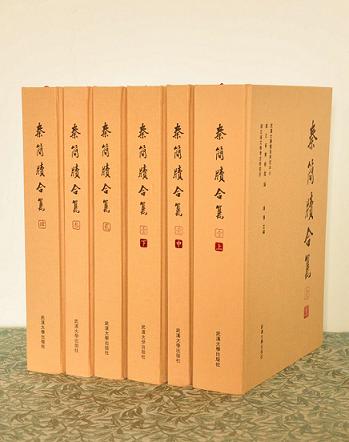Milestone in studies of Qin bamboo slips

Bamboo Slip Collections of Qin Dynasty
Editor-in-chief: Chen Wei
Publisher: Wuhan University Press
The Qin Dynasty (221-206 BC) was the first to conquer all of China. The systems it adopted and measures taken had a profound influence on later generations. There is a saying that systems in the Han Dynasty (206 BC-AD 220) inherited those of the Qin. Many systems and practices, though they differed in name or format, can be dated back to the Qin era. The short-lived reign of the leadership, coupled with an incident in which numerous precious classical books were burnt, left few documents passed down to the present, making studies of the Qin Dynasty rather difficult.
A discovery at the Qin tombs in Shuihudi at Yunmeng County, Hubei Province in 1975 opened a new chapter for these studies. In the 40 years onward, 12 batches of bamboo slips from the Qin State or Qin Dynasty were recovered, amounting to a total of 45,000 pieces. The materials cover a range of aspects, from laws and calendars to administrative records and medical books, injecting great vitality into the studies of Qin history.
Since 1977, there have been a number of papers and books on the topic. Bamboo Slip Collections of the Qin Dynasty was the result of five years of collaboration between the Center of Bamboo and Silk Manuscripts of Wuhan University, museums and other cultural institutions. Taking advantage of new technology and previous achievements, the first part, in four volumes, reviewed and collated six out of the 12 batches of Qin bamboo slips, titled Shuihudi, Zhoujiatai, Longgang, Yueshan, Haojiaping and Fangmatan.
The academic significance of the book can be summarized as follows:
First, it provides the finest pictured version of the six batches of Qin bamboo slips. Not only did the editors strive to collect high-resolution photos depicting the slips after they were first evacuated but they also included infrared pictures with clear writing. In addition, it included photos enlarged to twice the size so readers can examine and interpret the items at their discretion.
Second, it makes progress in terms of interpretation by rejoining some slips and providing context. Finally, it offers new insight into the notes of the Qin bamboo slips.
Though it might seem trivial, the actual academic significance is beyond estimation. In fact, any breakthroughs in key phrases and sentences may reveal a new understanding of these documents, giving us a better profile of the Qin state and Qin Dynasty.

 PRINT
PRINT CLOSE
CLOSE